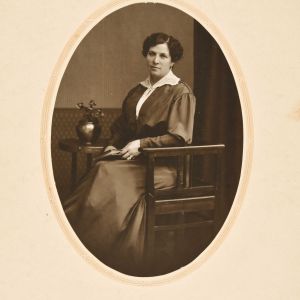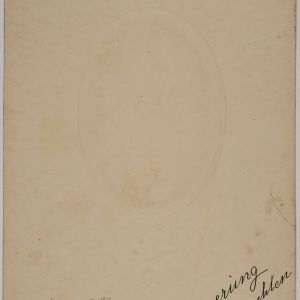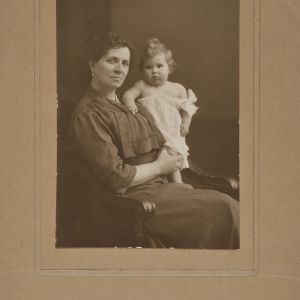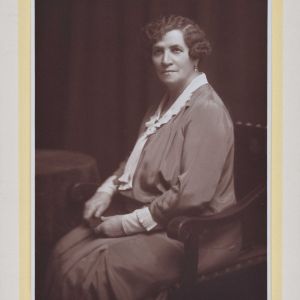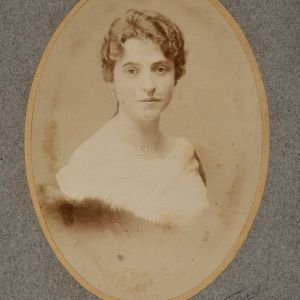Alexandru Mocioni Square
"Made in neo-baroque Secession and Eclectic styles, the palaces give a special appearance to the southern front of the Mocioni Square.
Listen to the audio version.
Alexandru Mocioni Square is crossed diagonally by 16 Decembrie 1989 Boulevard, which thus divides the square into two distinct parts, the two having unequal shapes and surfaces. The southeastern part of the Mocioni square, having a trapezoidal shape and being initially organized as an urban square, was administratively part of the Elisabetin neighborhood and was called Josif Square, and later Asănești. In 1894, the municipality acquired the land of the former esplanade, but the initial attempts to sell the new plots did not produce the expected results. It was only in 1901 that buildings were built on the southern front of the square, a location belonging to the Elisabetin neighborhood.
In Mocioni Square, at no. 3, the string of the imposing buildings built at the beginning of the XX century begins with the Dauerbach Palace, built in 1901, within nine months. A three-level building, built in an eclectic style, Dauerbach Palace opens, from east to west, the string of palaces in Mocioni Square. Among the most important decorative elements are the medallions framed by acanthus leaves under the attic in the central area and at the edges, the cornice with redani, the decorative garlands under the windows on the second floor, and the windows with strongly profiled frames with stucco motifs.
Next is the house of the architect Karl Hart, a building located in Mocioni Square, at no. 4, built in 1901, in only five and a half months, by the architect of the same name. The palace is among the few buildings in eclectic style with neo-baroque influences (in the area of the timpanis at the top of the building, the decoration above the balcony access) and neoclassical (modillion under the cornice, window frames on the second floor) made în Timișoara after 1900. At present, the facade of the palace is in an advanced state of degradation. Above the central window upstairs you can see a decorative coat of arms with the monogram "KH", representing the initials of the architect and also the owner of the building.
The next palace, from no. 5, is the house of Jakob Fischer, designed by the architect Gabor Fodor and built in 1910, within seven months. It belongs to the Secession style and is highlighted by the second-floor window frames and the feminine masks on the main façade.
In the same Mocioni square, at no. 6, corner with I. Heliade Rădulescu street, there are the three attached palaces of Béla Fiatska, built in 1910-1911. The architectural ensemble was designed with two floors for each palace, the windows of the three buildings representing their common element. Placed at the same height, the windows are differentiated by the decoration of the frames, thus giving the facades a different appearance, although they all fit in the same Secession style.
Bibliography:
- http://www.timisoara-info.ro/ro/atracii-turistice/cartiere-istorice/iosefin/obiective/178-palatele-piata-mocioni.html site accessed on March 15, 2020 .
- https://www.pressalert.ro/2014/05/timisoara-uitata-casele-vechi-din-elisabetin-intre-ruine-si-bijuterii/ site accessed on March 15, 2020 .
- https://heritageoftimisoara.ro/cladiri/Elisabetin/adresa/Alexandru+Mocioni/4 site accessed on March 15, 2020 .
- https://www.turdearhitectura.ro/ro/blog/pia-mocioni/ site accessed on March 15, 2020 .
Pia Brînzeu, Family Journal, Manuscript
Stop 3: The row of palaces in Al. Mocioni Square
July 4, 1937 Mother is seventeen years old. She’s getting ready to go to Innsbruck, to spend her holidays at her grandmother’s. She’s packing. She will take all the little dresses made by Mrs. Traxel: the linen dress with tiny blue flowers, the red velvet dress and the black silk dress, for special occasions. She won’t forget the white trousers, a novelty which she is very fond of. Grandfather would not let her wear trousers, she looks too extravagant in them, but Mother won’t listen to him. She feels good in those trousers, she is free to move as she likes, and they are very comfortable when hiking on the mountains.
My mother’s grandmother lives on Meran Street, at number 4. It’s right in the city centre. Tante Mizzi and cousin Helmuth live on the floor underneath. At five o’clock, mother is always invited to coffee, and cannot wait to go downstairs to see them. Several of Helmuth’s friends come usually and through them she gets to know the upper class in the city. At Easter, Fritz, a fragile, talkative young man, wanted to meet her. He invited her out for a walk and then he suddenly disappeared, claiming he’d been called by his grandfather to the factory. They had manufacturing problems again. Since March, when Austria was annexed to Germany, they have been making not only jewelleries, but also lenses for binoculars, telescopes and magnifying glasses. All for the Wehrmacht, all for the war.
Fritz will also come at five o’clock. Grandmother urges her to be nice to him, since she knows his entire family. Mother doesn’t really like Fritz, she’s more into Manfred, his brother, but Manfred already has a sweetheart. Still, she drinks her coffee fast and pleases her grandma, joining Fritz for a walk through the city. The only thing the young man seems to be doing today is talk about his grandfather, a simple apprentice from Bohemia, obsessed with the shining of glass. When he was young, he used to spend his entire day in his workshop, thinking about how to polish the stones more easily. When he found a new method, he patented it and thus he could become independent. He began his journey around the empire to search for waters which would provide him with the necessary energy for a factory and settled in Wattens, near Innsbruck.
“Glass stones shine like the eyes of girls who are in love”, Fritz whispers to my mother, “and girls who are in love become good wives, don’t they?” “Not at all”, my mother replies, “the eyes of girls who are in love shine like diamonds, not like beads of coloured glass.” That’s why, she says to herself, she never wore the bracelet she got from Fritz. It lies untouched in a jewellery box back home, in Timişoara; it’s too obvious that it is made of glass. And that’s the very reason why she would not marry him. Why would she want to be surrounded all her life by people enslaved to coloured glass? “A genuine precious stone, no matter how small”, my mother continues out loud, “is more beautiful than the fanciest synthetic stones.” “You’re wrong,” Fritz contradicts her, “many, many shiny stones create the illusion of stars in the sky and women love to be surrounded by them, to feel like they can fly among the stars. You can’t do that with diamonds, it’s too expensive...” That’s the temptation that Fritz’s grandfather relies on, and his grandson agrees with him, he likes the old man’s philosophy and believes in it. It will certainly bring them a lot of money. What he doesn’t like is the edelweiss flower chosen as a logo for their jewelleries. When grandfather can’t oppose him anymore, Fritz will replace the edelweiss with a white swan. Delicate, graceful and with a long neck, just like the first letter of their family name, Swarovski...
Timisoara, a fairytale place
by Matei Popa, 7th grade
"Grigore Moisil" Theoretical High School Timișoara
In the pages of history, Timisoara writes its own story,
With words that remain vivid and meaningful.
On its cobbled streets walk the shadows of the past,
And the echoes of heroes can be heard in every corner and in every stone.
On the outskirts of the city, in chestnut and acacia woods,
They say there are still sighs of love and unfulfilled longings.
Love stories grow under the starry sky on the banks of the Bega,
And old legends handed down from generation to generation, like the wind caressing the leaves of old trees.
In Union Square, the heart of the city beats faster,
Among buildings and fountains shimmering in the moonlight.
Political meetings and plots take place here,
And they say that every stone holds a secret waiting to be revealed.
The narrow streets of the Citadel hide mysteries and mysteries,
And every corner has a story waiting to be discovered.
With every step, you feel like you're stepping into another era,
And you can hear the sighs of yesteryear and the laughter of children running through the old streets.
Revolutionary stories and ideas are born in bohemian cafés,
Where poets and intellectuals find refuge in words and thoughts.
At a coffee table or under gas lamps,
It sparks heated discussions and plans that will change the course of history.
On the outskirts of the city, in suburbs and suburban neighborhoods,
Stories of life and struggle for survival emerge.
Every house and courtyard has a story,
And everyone is proud of their ancestral traditions and customs.
On the border between past and present, Timisoara is building its future,
With confidence and determination, overcoming obstacles as they arise.
Every day, a new page is written in the book of his destiny,
And each inhabitant adds their personal story to the city's rich tapestry.
In the Central Park, under the shade of ancient trees,
Stories of friendship and love, joy and sadness unfold.
Every bench and alley hides memories and stories,
And every visitor adds a new chapter to the park's beautiful book.
On the border between reality and fantasy, Timisoara becomes a magical place,
Where fabulous characters meet mythical creatures.
Fairytale scenes unfold in the narrow streets and crowded squares,
And every inhabitant becomes part of a story that transcends the boundaries of reality.
At the crossroads of cultures and traditions, Timisoara becomes a melting pot of diversity,
Where customs and rituals from all corners of the world intertwine.
Every festival and holiday celebrates unity in diversity,
And everyone feels proud to be part of this multicultural city.
On the outskirts and in the heart of the city, nature shows its splendor,
In gardens and parks that stretch on forever.
Every tree and flower tells its story,
And every river and lake becomes a testament to the beauty of the city.
Through the passing years and the changes that come with them,
Timisoara remains a place full of charm and mystery.
In the hearts of the inhabitants and in their ancestral memories,
It keeps alive the flame that ignites the spirit of the city and gives it life.
At the end of the journey through Timișoara's Stories,
I turn wistfully to the city in front of me.
With a heart full of memories and a soul enriched by experiences,
I am slowly drifting away from this place of stories and magic.
With the promise that I will come back one day to discover new stories,
I leave with a light step and a smile on my lips, because I know that this city,
With all its stories, it will always be alive and vibrant,
A place where history intertwines with the present, and the future always shines in the distance.
At the crossroads, I reach up to the sky and say one last thought,
Thanking Timisoara for its beauty and wonderful stories.
With a heart full of gratitude and the desire to return,
I am leaving for new adventures, but with the promise that the memories of Timisoara will always remain alive in my soul.
–-
In my early student years I moved to Timișoara on a small but charming street in Mocioni Square called Emanoil Gojdu. It was love at first sight, as I was to find out that the building I was to live in, with its inner courtyard and beautiful garden, was in fact a mansion.
It had become my little piece of heaven in a big, yet unknown city. The guitar of the downstairs neighbour on summer evenings, the smell of the clothes hung out to dry in a corner of the courtyard by the neighbour on the first floor, the father of a neighbour who always came to visit to tend the garden with "his lady" because "time passes more beautifully", the laughter of little Petra when she played with the cats, all have remained as a vivid memory in my mind whenever I think of this place.
But this wasn't the only place so enchanting that it felt like it was part of another world. Right next door, at number 7, was the palace of Baron Bela Gudenus de Gad, with admirable architecture that perfectly complemented the springtime shades of white and pink of the flowering trees lining both sides of the street. I never knew what it was called, but I learned through the Spotlight Heritage website that it belonged to a noble family in Austria.
At the street exits I had on one side the beautifully landscaped Bega, where children played, people ran, rode their bikes or their animals, and on the other side, on my way to the university, another dominant building with a special air: the second home of Valerie Pintea. It expresses so beautifully the feeling of a welcoming home full of stories, stories that I was astonished to learn with the help of Spotlight Timisoara are featured in the novel "Valeria Dr. Pintea" written by her granddaughter, Liana Maria Gomboșiu.
I couldn't help but notice how different the two street exits are but how well they complement each other to highlight the connection between "then" and "now". In the meantime, Timișoara has become "home" for me, because although it is constantly evolving, it manages to keep its former beauty that makes it fascinating and mysterious.

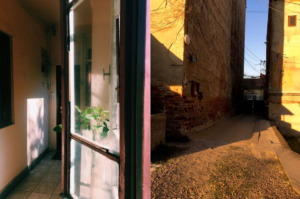

Codreanu Bianca, Student UPT, 2023









